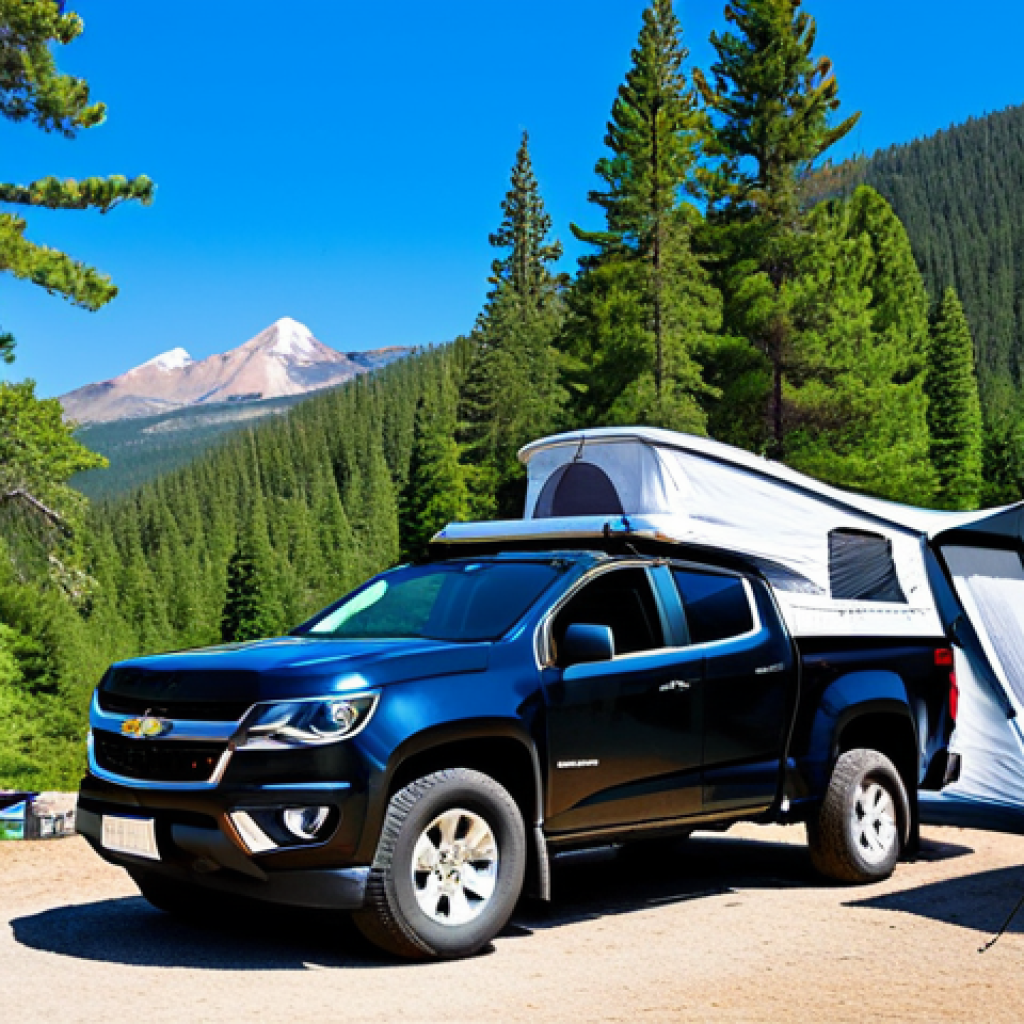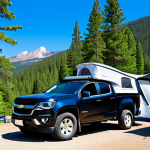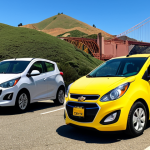The allure of the open road, the crackling campfire under a starlit sky – camping embodies freedom. But what if you could elevate that experience? Imagine transforming a rugged Chevrolet Colorado into a personalized camping haven, a seamless blend of adventure and comfort.
Conversions are becoming increasingly popular, fueled by a desire for customized travel and the rising trend of “overlanding.” Experts predict a surge in demand for versatile vehicles adaptable to both daily life and weekend escapes.
From pop-up tents to fully equipped interiors, the possibilities are endless. Let’s delve into the world of Colorado camper conversions and see what’s possible.
Let’s uncover the details in the following article.
## Exploring the Appeal of Chevrolet Colorado Camper ConversionsThe Chevrolet Colorado isn’t just a truck; it’s a blank canvas for adventure. Its robust build and manageable size make it an ideal candidate for camper conversions.
But why are these conversions gaining traction? Well, it’s a confluence of factors. For starters, traditional RVs can be cumbersome and expensive.
A Colorado camper conversion offers a more agile and affordable alternative. Plus, there’s a certain DIY spirit that appeals to those who crave a more hands-on approach to travel.
It’s about crafting a personalized space that reflects your individual needs and tastes, whether it’s a minimalist setup for weekend getaways or a more elaborate build for extended road trips.
People are increasingly valuing experiences over possessions, and what better way to experience the great outdoors than with a customized camper?
Tailoring Your Colorado for the Ultimate Camping Experience
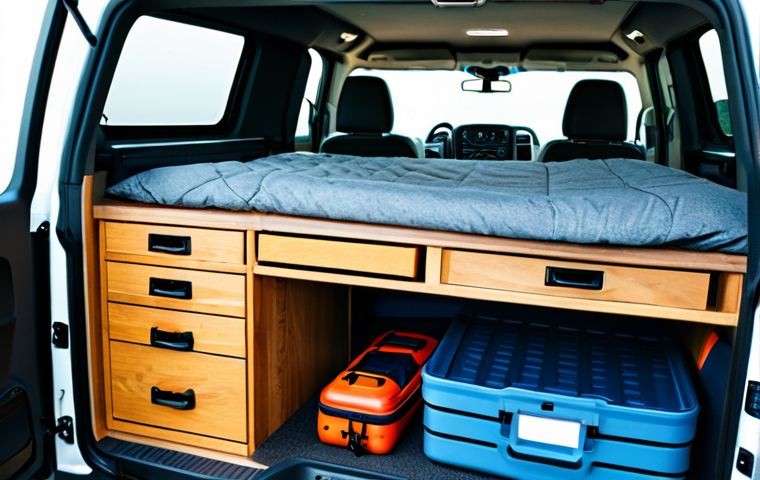
Converting your Colorado into a camper isn’t just about slapping a tent on the back; it’s about thoughtfully designing a space that caters to your specific needs.
Here are some key considerations:1. Pop-Up Tents and Roof Top Tents: These are popular choices for their ease of setup and storage. A roof top tent, for example, mounts directly to the bed rack, providing a sleeping platform that keeps you off the ground and away from critters.
I’ve used a roof top tent on my own truck and can attest to the convenience of having a ready-to-go bedroom wherever I park. The downside can be climbing up and down the ladder in the middle of the night for bathroom breaks, but the views and convenience often outweigh this minor inconvenience.
Pop-up tents are another solid option and are typically more budget-friendly and quicker to set up, although they may not offer the same level of weather protection.
2. Interior Build-Outs: For those seeking more comfort and functionality, an interior build-out might be the way to go. This could involve installing custom cabinetry for storage, a small kitchenette with a portable stove and sink, and even a bed platform.
A well-designed interior can transform your Colorado into a miniature home on wheels. My friend converted his truck and included a slide-out kitchen and a fold-down bed.
It was incredible how much functionality he packed into such a small space. 3. Power Solutions: Don’t forget about power!
Solar panels, auxiliary batteries, and a reliable inverter are essential for keeping your devices charged and running appliances like refrigerators or lights.
I once went camping without a proper power setup and learned my lesson the hard way – a dead phone and warm beverages are not conducive to a relaxing trip!
Optimizing Space: Clever Storage Solutions for Your Colorado Camper
Space is a premium in any camper conversion, especially in a mid-size truck like the Colorado. Maximizing every nook and cranny is crucial for a comfortable and functional setup.
Let’s explore some ingenious storage ideas that can make a big difference:1. Drawer Systems: Under-bed drawer systems are a fantastic way to utilize the often-wasted space beneath your sleeping platform.
These drawers can be customized to fit your specific gear, from cooking supplies to clothing. I built my own drawer system using plywood and heavy-duty drawer slides, and it’s been a game-changer for keeping my gear organized and easily accessible.
2. Overhead Storage: Installing overhead cabinets or shelves can provide additional storage for lighter items like bedding, books, or toiletries. Be sure to secure everything properly to prevent items from shifting during travel.
I’ve seen some incredibly creative overhead storage solutions using repurposed materials like old ammunition boxes or even repurposed kitchen cabinets.
3. Vertical Storage: Think vertically! Utilizing wall-mounted organizers or hanging nets can free up valuable floor space.
Consider installing a magnetic knife strip for your cooking utensils or a hanging shoe organizer for smaller items. When I converted my camper I used some industrial strength velcro and it works magic.
The Financial Side: Costs and Budgeting for a Colorado Camper Conversion
Converting your Colorado into a camper can range from a budget-friendly DIY project to a more elaborate professional build. Understanding the potential costs involved is essential for planning your conversion:1.
DIY vs. Professional: A DIY conversion can save you a significant amount of money, but it requires time, skills, and access to tools. A professional conversion, on the other hand, can be more expensive but offers expertise and a guaranteed outcome.
I know a lot of people who chose the DIY method and regretted it because they didn’t have the right tools. Make sure you have everything you need before you start or you might end up spending the same amount of money on tools anyway.
2. Component Costs: The cost of individual components can vary widely depending on quality and features. A basic roof top tent might cost around $1,000-$3,000, while a more elaborate interior build-out could easily exceed $5,000.
Solar panels, batteries, and other electrical components can also add significantly to the overall cost. 3. Hidden Expenses: Don’t forget to factor in hidden expenses like permits, modifications to your truck’s suspension, and unforeseen repairs.
It’s always a good idea to have a buffer in your budget to cover unexpected costs. For instance, if you change the roof of your truck, or add a lot of weight to the vehicle, you may want to get it inspected to make sure it is safe to drive.
Choosing the Right Gear: Essential Equipment for Your Colorado Camping Setup
Having the right gear can make or break your camping experience. Here are some essential items to consider for your Colorado camper setup:1. Sleeping Gear: A comfortable sleeping setup is paramount.
Invest in a high-quality sleeping bag or quilt, a comfortable sleeping pad, and pillows. I prefer a down-filled sleeping bag for its warmth and packability, but synthetic options are also available.
2. Cooking Equipment: Whether you’re a gourmet chef or prefer simple meals, having the right cooking equipment is essential. A portable stove, cookware, utensils, and a cooler are all must-haves.
I personally swear by my portable propane stove and cast iron skillet – they’re perfect for cooking up hearty meals in the great outdoors. 3. Navigation and Safety: Don’t rely solely on your phone for navigation.
Carry a paper map and compass as backup, and invest in a good GPS device. A first-aid kit, emergency blanket, and communication device (like a satellite phone or two-way radio) are also essential for safety.
Maintaining Your Colorado Camper: Ensuring Longevity and Reliability
Proper maintenance is crucial for ensuring the longevity and reliability of your Colorado camper conversion. Here are some key maintenance tips:1. Regular Inspections: Regularly inspect your camper for signs of wear and tear.
Check for leaks, loose connections, and damage to the interior or exterior. Addressing minor issues promptly can prevent them from escalating into major problems.
2. Cleaning and Storage: Keep your camper clean and dry to prevent mold and mildew growth. Store it in a covered location when not in use to protect it from the elements.
3. Mechanical Maintenance: Don’t neglect the mechanical maintenance of your Colorado. Follow the manufacturer’s recommended maintenance schedule for oil changes, fluid checks, and other essential services.
Colorado Camper Conversion: Key Considerations
Here is some information that needs to be considered when converting your camper.
| Consideration | Details |
|---|---|
| Budget | Determine a realistic budget for the conversion, including materials, labor (if applicable), and unforeseen expenses. |
| Space Optimization | Plan the layout carefully to maximize space utilization. Consider multi-functional furniture and clever storage solutions. |
| Weight Management | Be mindful of the added weight from the conversion, as it can impact fuel efficiency and handling. Consider upgrading the suspension if necessary. |
| Power Needs | Assess your power requirements and choose appropriate power sources, such as solar panels, auxiliary batteries, and inverters. |
| Ventilation | Ensure adequate ventilation to prevent condensation and maintain air quality. Consider installing a roof vent or fan. |
| Local Regulations | Research local regulations and restrictions regarding camper conversions to ensure compliance. |
| DIY Skills | Assess your DIY skills and consider hiring professionals for tasks you’re not comfortable with. |
Exploring the Appeal of Chevrolet Colorado Camper Conversions
The Chevrolet Colorado isn’t just a truck; it’s a blank canvas for adventure. Its robust build and manageable size make it an ideal candidate for camper conversions. But why are these conversions gaining traction? Well, it’s a confluence of factors. For starters, traditional RVs can be cumbersome and expensive. A Colorado camper conversion offers a more agile and affordable alternative. Plus, there’s a certain DIY spirit that appeals to those who crave a more hands-on approach to travel. It’s about crafting a personalized space that reflects your individual needs and tastes, whether it’s a minimalist setup for weekend getaways or a more elaborate build for extended road trips. People are increasingly valuing experiences over possessions, and what better way to experience the great outdoors than with a customized camper?
Tailoring Your Colorado for the Ultimate Camping Experience
Converting your Colorado into a camper isn’t just about slapping a tent on the back; it’s about thoughtfully designing a space that caters to your specific needs. Here are some key considerations:
- Pop-Up Tents and Roof Top Tents: These are popular choices for their ease of setup and storage. A roof top tent, for example, mounts directly to the bed rack, providing a sleeping platform that keeps you off the ground and away from critters. I’ve used a roof top tent on my own truck and can attest to the convenience of having a ready-to-go bedroom wherever I park. The downside can be climbing up and down the ladder in the middle of the night for bathroom breaks, but the views and convenience often outweigh this minor inconvenience. Pop-up tents are another solid option and are typically more budget-friendly and quicker to set up, although they may not offer the same level of weather protection.
- Interior Build-Outs: For those seeking more comfort and functionality, an interior build-out might be the way to go. This could involve installing custom cabinetry for storage, a small kitchenette with a portable stove and sink, and even a bed platform. A well-designed interior can transform your Colorado into a miniature home on wheels. My friend converted his truck and included a slide-out kitchen and a fold-down bed. It was incredible how much functionality he packed into such a small space.
- Power Solutions: Don’t forget about power! Solar panels, auxiliary batteries, and a reliable inverter are essential for keeping your devices charged and running appliances like refrigerators or lights. I once went camping without a proper power setup and learned my lesson the hard way – a dead phone and warm beverages are not conducive to a relaxing trip!
Optimizing Space: Clever Storage Solutions for Your Colorado Camper
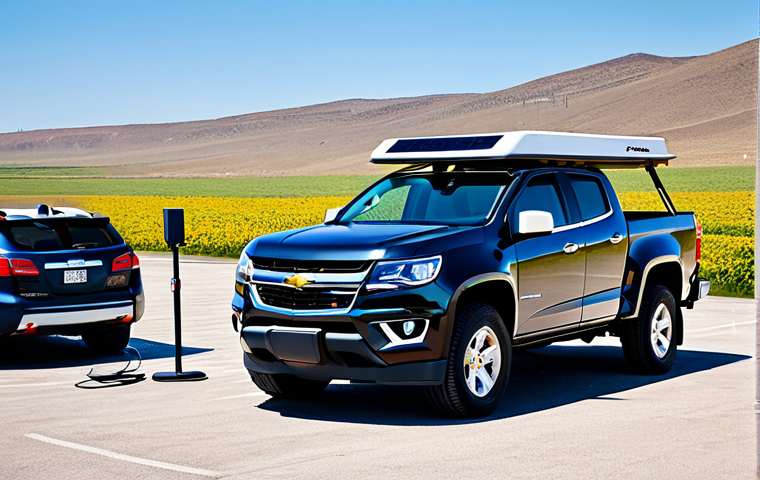
Space is a premium in any camper conversion, especially in a mid-size truck like the Colorado. Maximizing every nook and cranny is crucial for a comfortable and functional setup. Let’s explore some ingenious storage ideas that can make a big difference:
- Drawer Systems: Under-bed drawer systems are a fantastic way to utilize the often-wasted space beneath your sleeping platform. These drawers can be customized to fit your specific gear, from cooking supplies to clothing. I built my own drawer system using plywood and heavy-duty drawer slides, and it’s been a game-changer for keeping my gear organized and easily accessible.
- Overhead Storage: Installing overhead cabinets or shelves can provide additional storage for lighter items like bedding, books, or toiletries. Be sure to secure everything properly to prevent items from shifting during travel. I’ve seen some incredibly creative overhead storage solutions using repurposed materials like old ammunition boxes or even repurposed kitchen cabinets.
- Vertical Storage: Think vertically! Utilizing wall-mounted organizers or hanging nets can free up valuable floor space. Consider installing a magnetic knife strip for your cooking utensils or a hanging shoe organizer for smaller items. When I converted my camper I used some industrial strength velcro and it works magic.
The Financial Side: Costs and Budgeting for a Colorado Camper Conversion
Converting your Colorado into a camper can range from a budget-friendly DIY project to a more elaborate professional build. Understanding the potential costs involved is essential for planning your conversion:
- DIY vs. Professional: A DIY conversion can save you a significant amount of money, but it requires time, skills, and access to tools. A professional conversion, on the other hand, can be more expensive but offers expertise and a guaranteed outcome. I know a lot of people who chose the DIY method and regretted it because they didn’t have the right tools. Make sure you have everything you need before you start or you might end up spending the same amount of money on tools anyway.
- Component Costs: The cost of individual components can vary widely depending on quality and features. A basic roof top tent might cost around $1,000-$3,000, while a more elaborate interior build-out could easily exceed $5,000. Solar panels, batteries, and other electrical components can also add significantly to the overall cost.
- Hidden Expenses: Don’t forget to factor in hidden expenses like permits, modifications to your truck’s suspension, and unforeseen repairs. It’s always a good idea to have a buffer in your budget to cover unexpected costs. For instance, if you change the roof of your truck, or add a lot of weight to the vehicle, you may want to get it inspected to make sure it is safe to drive.
Choosing the Right Gear: Essential Equipment for Your Colorado Camping Setup
Having the right gear can make or break your camping experience. Here are some essential items to consider for your Colorado camper setup:
- Sleeping Gear: A comfortable sleeping setup is paramount. Invest in a high-quality sleeping bag or quilt, a comfortable sleeping pad, and pillows. I prefer a down-filled sleeping bag for its warmth and packability, but synthetic options are also available.
- Cooking Equipment: Whether you’re a gourmet chef or prefer simple meals, having the right cooking equipment is essential. A portable stove, cookware, utensils, and a cooler are all must-haves. I personally swear by my portable propane stove and cast iron skillet – they’re perfect for cooking up hearty meals in the great outdoors.
- Navigation and Safety: Don’t rely solely on your phone for navigation. Carry a paper map and compass as backup, and invest in a good GPS device. A first-aid kit, emergency blanket, and communication device (like a satellite phone or two-way radio) are also essential for safety.
Maintaining Your Colorado Camper: Ensuring Longevity and Reliability
Proper maintenance is crucial for ensuring the longevity and reliability of your Colorado camper conversion. Here are some key maintenance tips:
- Regular Inspections: Regularly inspect your camper for signs of wear and tear. Check for leaks, loose connections, and damage to the interior or exterior. Addressing minor issues promptly can prevent them from escalating into major problems.
- Cleaning and Storage: Keep your camper clean and dry to prevent mold and mildew growth. Store it in a covered location when not in use to protect it from the elements.
- Mechanical Maintenance: Don’t neglect the mechanical maintenance of your Colorado. Follow the manufacturer’s recommended maintenance schedule for oil changes, fluid checks, and other essential services.
Colorado Camper Conversion: Key Considerations
Here is some information that needs to be considered when converting your camper.
| Consideration | Details |
|---|---|
| Budget | Determine a realistic budget for the conversion, including materials, labor (if applicable), and unforeseen expenses. |
| Space Optimization | Plan the layout carefully to maximize space utilization. Consider multi-functional furniture and clever storage solutions. |
| Weight Management | Be mindful of the added weight from the conversion, as it can impact fuel efficiency and handling. Consider upgrading the suspension if necessary. |
| Power Needs | Assess your power requirements and choose appropriate power sources, such as solar panels, auxiliary batteries, and inverters. |
| Ventilation | Ensure adequate ventilation to prevent condensation and maintain air quality. Consider installing a roof vent or fan. |
| Local Regulations | Research local regulations and restrictions regarding camper conversions to ensure compliance. |
| DIY Skills | Assess your DIY skills and consider hiring professionals for tasks you’re not comfortable with. |
Concluding Thoughts
Embarking on a Colorado camper conversion is an exciting endeavor that blends adventure with personalization. From weekend escapes to cross-country odysseys, your converted truck can be a ticket to unparalleled freedom. Just remember to plan diligently, consider all the factors, and most importantly, enjoy the journey of creating your perfect mobile haven.
Happy trails and safe travels!
Handy Tips and Tricks
Here are some handy tips and tricks to make your Colorado camper conversion even better:
1. Use Reflectix insulation to line the walls and ceiling of your camper for temperature control.
2. Install a swivel seat on the passenger side for more flexible living space.
3. Create a portable toilet setup using a 5-gallon bucket and toilet seat.
4. Invest in a good quality awning for shade and protection from the elements.
5. Learn basic carpentry and electrical skills to handle repairs and modifications on the road.
Key Takeaways
In conclusion, converting your Chevy Colorado into a camper is a rewarding project if you keep these main points in mind:
Careful Planning: Ensure you have a solid plan to maximize space and stay within your budget.
Safety First: Prioritize safety by including essential items like a first-aid kit and reliable navigation tools.
Regular Maintenance: Stay on top of maintenance to keep your camper in great condition for years to come.
Frequently Asked Questions (FAQ) 📖
Q: What kind of camper conversions are possible for a Chevy Colorado?
A: Honestly, the sky’s the limit! You can go basic with just a simple truck bed tent or a rooftop tent setup. I’ve seen those, and they’re great for a quick weekend getaway.
Then there are the more elaborate conversions involving pop-up campers that mount right onto the bed. Those give you a bit more space and comfort. And for the serious overlander, people are building out full interior builds with kitchens, sleeping platforms, and even small bathrooms!
I saw one dude online completely transform his Colorado into a tiny home on wheels; it was seriously impressive. The cost really depends on how fancy you wanna get.
Q: Is converting a Colorado into a camper van expensive?
A: That’s a loaded question, right? Because “expensive” is relative. But yeah, it can definitely add up.
A basic tent setup might only set you back a few hundred bucks. But if you’re talking about a full-blown interior conversion with custom cabinetry, electrical systems, and plumbing?
You could easily be looking at several thousand dollars, maybe even tens of thousands. When I was pricing things out for my own (much smaller) DIY camper build, I was shocked at how much things like solar panels and quality batteries cost.
Plus, labor costs if you’re not doing the work yourself can be significant. My advice? Get quotes from a few different conversion companies and really think about what features you need versus what would just be nice to have.
That can help you keep the budget in check.
Q: Will converting my Colorado hurt its resale value?
A: This is a tough one. It really depends on the quality of the conversion and who you’re selling it to. A poorly done, Frankenstein-esque conversion could definitely hurt the value.
I’ve seen some real DIY disasters out there! However, a professionally done conversion or a well-thought-out DIY job with quality components might actually increase the value, especially if you find a buyer who’s specifically looking for a camper van.
Think about it: a standard Colorado has a certain market, but a Colorado that’s ready to hit the road for camping trips has a much more niche and potentially lucrative market.
My gut tells me that it would depend on how well you maintain your Colorado after the conversion as well.
📚 References
Wikipedia Encyclopedia
